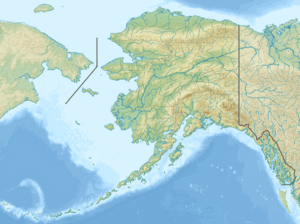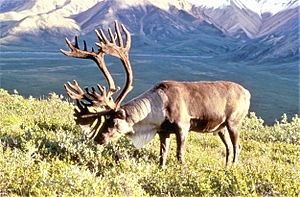Tubutulik River facts for kids
Quick facts for kids Tubutulik River |
|
|---|---|
|
Location of the mouth of the Tubutulik River in Alaska
|
|
| Country | United States |
| State | Alaska |
| Region | Seward Peninsula |
| District | Nome Census Area |
| Physical characteristics | |
| Main source | Bendeleben Mountains 1,865 ft (568 m) 65°15′49″N 162°34′57″W / 65.26361°N 162.58250°W |
| River mouth | Kwiniuk Inlet on Norton Bay 25 miles (40 km) southwest of Koyuk 64°44′22″N 161°53′17″W / 64.73944°N 161.88806°W |
| Length | 25 mi (40 km) |
The Tubutulik River is a river in Alaska, a state in the United States. This river is about 25-mile (40 km) long. It is found on the Seward Peninsula. The Tubutulik River flows towards the southeast. It empties into the Kwiniuk Inlet. This inlet is part of Norton Bay in the Bering Sea. The inlet is about 25 miles (40 km) southwest of Koyuk.
The name "Tubutulik" comes from the Inuit people. It was first recorded as "Tubuktulik" in 1849. This was done by Captain Mikhail Dmitrievich Tebenkov. He was part of the Imperial Russian Navy. People started looking for gold in the river valley in the late 1800s. Gold mining began in 1898. The amount of gold found here was very large. It was the second-highest amount after Nome.
Contents
Where is the Tubutulik River Located?
The Tubutulik River is in northwestern Alaska. It is on the Seward Peninsula. The river starts in the southern part of the Bendeleben Mountains. There is a large crack in the Earth's crust, called a fault, near the river's source. This fault runs from the Bendeleben Mountains.
The river flows mostly in the same direction as the mountains. However, smaller streams that flow into it, called tributaries, run across the mountains. The river valley often experiences erosion. This means the land is worn away by water. Because of this, there are many lakes and wet areas called sloughs in the valley.
The River's Path and Features
The first 17–18 miles (27–29 km) of the Tubutulik River is very winding. It twists and turns through flat areas. These flats are made of sand and mud brought down by the river. After these flats, the valley becomes narrower. To the west are high hills made of granite. To the east are softer hills made of limestone and schist.
The river passes by the mouth of Chukajak Creek. Other streams like Vulcan Creek also join the river from the west. Further upstream, the Tubutulik River flows through a narrow canyon. Above this canyon, the valley widens again. This wider area is similar to the basin of the Fish River. A low pass connects these two areas. People use this pass in winter to travel between Golovnin Bay and Kotzebue Sound. You can see the edges of this basin from the Bendeleben Mountains. A sand spit, which is a narrow piece of land, lies across from the river's mouth.
The Tubutulik River flows mostly through a hilly area. This area separates the valleys of the Koyuk and Fish Rivers. The Tubutulik River starts in granite mountains. These mountains are south of where the Koyuk River begins. The Tubutulik then flows into a small basin. After this, it enters the hills again. From there, it continues with many loops and bends. Its valley changes in width. It finally reaches its delta plain about 11–12 miles (18–19 km) before its mouth.
River Branches and Delta
The largest stream that flows into the Tubutulik River is Clear Creek. It joins from the southwest. Other smaller branches include Vulcan, Chukajak, Admiral, Grouse, and Lost creeks. Vulcan and Chukajak creeks are the main ones that belong to the Tubutulik River system.
The lower part of the river flows through a flat plain. This plain has both fresh and saltwater marshes. It is formed by mud, sand, and gravel carried by the river. This material is dropped off at the river's mouth. The river empties into a lagoon. This lagoon is behind a long island made of sand. The Kwiniuk River also flows into this lagoon from its western end.
Animals and Plants in the River Area
The area around the Tubutulik River is very important for many animals. Especially in the Norton Sound area, many types of Pacific salmon live here. Other fish species also make their home in these waters.
The river's watershed is also a place for migratory birds. These birds fly long distances to feed and nest here. Caribou from the Western Arctic herd also come to this area to find food.
What is the Geology of the River Basin?
The land around the Tubutulik River has many interesting rock formations. For example, there is a wide band of granite rock. This granite crosses the Kwinium River to the south.
Gold mining started in the river basin in 1900. People found large pieces of gold by sifting through the surface gravels. Rocks made of many different pieces stuck together, called conglomerates, were also found in the riverbed. Basalt rock formations were recorded near the river's source. These were found between the Tubutulik River and Grouse Creek.
Scientists also tested the area for radioactivity. They found unusual levels of radioactivity in many places along the Tubutulik River and its branches. Three specific areas on the Tubutulik River showed very high radioactivity. Samples were taken from the granite rocks in the river valley. These samples were tested. The results showed high levels of radioactive uranium. Some samples had more than 0.2% of equivalent uranium.
How is the River Managed?
When gold mining started, new roads and railroads were built. A port was also developed. These activities caused some environmental problems. They threatened the homes of fish and other wildlife.
To help fix these issues, the Watershed Council is working on solutions. They are working with the Native Alaskan Tribal Government. They also partner with the Norton Bay Inter-Tribal Watershed Council (NBITWC). Their goal is to protect the river and its surrounding environment.



